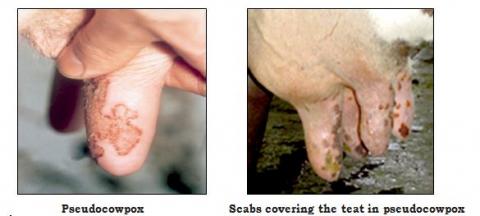- The most common infectious cause of teat disease in cattle.
- Caused by a virus and not to be confused with cowpox, which is rare.
- Since immunity is short-lived, cows can get infected fairly soon (often less than six months)
- after recovering from the disease.
SYMPTOMS
- Initial infection causes a small area of swelling and reddening on the teat.
- Over the next two days, the affected area elevates into an orange papule, which then scabs over.
- Seven to ten days after first signs the scabs start dropping off. This often leaves a horse-shoe or ring shaped area, which is very characteristic of pseudocowpox.
- Affected areas may grow together leading to scabs covering the entire length of the teat.
- Damaged teats are usually healed around a month after first signs.
- Lesions of pseudocowpox is usually found on the teat. However up to 10% of affected cows may have lesions on the udder skin.
- It can spread from cattle to man by contact. Skin infection in man is known as milker’s nodules, and is a painful localised infection.

PREVENTION
- Proper quarantine of newly purchased cows before introducing into the herd.
- Proper teat dipping using iodophor is one of the most effective means of control.
- Maintain proper hygiene in the shed.
TREATMENT
- Removal of scabs followed by application of a suitable disinfectant .
- Emollient teat dips and sprays have a beneficial effect of reducing bacteria and viruses on teat skin.
- Consult a veterinary doctor if above symptoms are seen.
